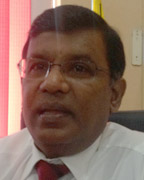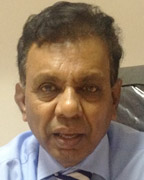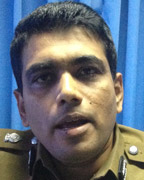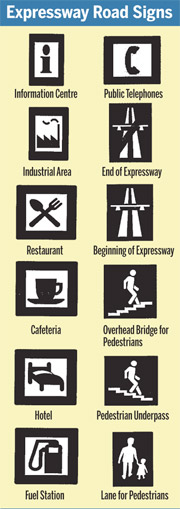New highway code for Expressways
By Kurulu Kariyakarawana
Motorways, highways or flyovers and serpentine exit routes are
advanced features in the modern road networks of developed countries
that we are finally privileged to experience in our own country. Fine
tarmac carpeted roads with multiple lanes give not only the sheer
driving pleasure with ample space but also the ability to reach the
expected destination with a pre-targeted time without fail.
 |
Commissioner
General
of Department of Motor
Traffic, S H Harishchandra |
 |
Former
Assistant Commissioner
(Technical),
A.W. Dissanayake |
 |
Police Media
Spokesman
SSP Ajith Rohana |
With all these advance features comes a modern set of laws and road
signs to be followed by the users for their own sake. Since the high
speed factor is involved with these roads the probability for dangerous
accidents is also expected to be high.
Unheeding road signs on highways as it is, is not a joke concerning
the amount of respect most of the ignorant local drivers have towards
the usage of the regular main roads. A simple miss or negligence could
cause a severe accident or a multiple vehicle collision on a highway,
again due to the speed factor and inability to control. Having not
familiarised with the road signs, especially the ones recently
introduced for highways is another problem that caused many accidents
recently.
In 2011 Sri Lanka was introduced to highways or expressways which
made life more convenient for constant travellers, road users and
logistic based transportation systems. With the launch of the Expressway
One (E1) connecting Colombo and Galle and now up to Matara, reduced an
approximate four to five hour journey to a one hour trip due to the
shortest stretch of the distance with an ability to accelerate into high
speed levels.
On the expressway the drivers had the chance to accelerate up to 100
kilometres an hour although the maximum speed limit allowed on a regular
road outside a town area is 72 kilometres per hour. Also the non
intervention of police officers armed with speed guns who jump out of
the woods made the expressway users more relaxed and to achieve higher
speed levels ignoring the 100 kilometre limit. Although high speed
driving at a steady level is a common feature of an expressway it should
not be taken lightly by any driver. Owning a sophisticated car that can
reach a high speed at any given time and a valid driver's license alone
are not a qualification to traverse on an expressway at his whim or
fancy.
Maintaining the proper speed only would not help if the other traffic
laws and road signs pertaining to the route are unheeded. This came into
consideration when a number of accidents were reported on E1 road during
the past couple of years mostly due to speeding.
Police reports and close circuit television camera footage of these
accidents conveyed only one message, that the drivers' incompetency to
maintain a steady drive at a high speed, and their lack of knowledge in
adhering to road signs had caused these accidents.
This was revealed when police investigated such accidents where they
were able to record statements from the surviving drivers, who had
claimed that although there were new road signs and instructions on how
to use the expressway, they were not very familiar with them.
 This was not a surprising answer as the drivers who obtain their
drivers license from the government Department of Motor Traffic were not
taught how to use a highway or an expressway before. This was not a surprising answer as the drivers who obtain their
drivers license from the government Department of Motor Traffic were not
taught how to use a highway or an expressway before.
Since the new laws and the road signs were not included in the
syllabus as well as in the learner's exam, neither the fresh license
holders nor the experienced drivers had a clue about this.
An ideal example for this was the recent accident on the newly
launched Colombo - Katunayake Expressway or the E3. A speeding vehicle
failing to control its speed at an entry point crashed into another
vehicle that crashed into another causing a multiple vehicle collision.
At least four vehicles were involved in the crash, giving the notion
that the local drivers are still not accustomed to the excessive speed
and control of an expressway.
According to police statistics a total of 816 accidents have been
reported from both the Southern Expressway and Colombo - Katunayake
Expressway since November 27, 2011 to date. Out of this, three accidents
had been reported on the Colombo - Katunayake Expressway, the first of
which was reported on November 3 this year.
Police Media Spokesman SSP Ajith Rohana said that 10 fatal accidents
are also included in the total figure which were mostly due to
collisions as a result of excessive speed. According to SSP Rohana
16,972 motor traffic violation cases on expressways had been filed in
courts to date. The common charges for these court cases were driving at
excessive speed, ignoring police signals and road signs as well as
drivers' negligence.
However, the fact that cannot be neglected was that, if there was a
set of laws and road signs exceptional to these expressways introduced
and familiarised with the drivers prior to the launch of these roads in
the country, it would have reduced the number of such occurrences.
When contacted, Commissioner General of Department of Motor Traffic S
H Harishchandra said that a new set of laws pertaining to the
expressways are being drafted presently and will be introduced to the
public in the near future. A new gazette will be issued with the
additions of these new regulations which is at the Department of Legal
Draftsman currently. The present gazette of Highway Code in Sri Lanka
has been created according to the Vienna Convention and the new gazette
is included with all the amendments to the old traffic laws and signs as
well as the new signs for the expressways.
The department has also taken measures to conduct special awareness
programs targeting driving examiners, driving instructors as well the
drivers themselves about the new laws. Booklets explaining how to use
expressways safely and effectively are being distributed among the
public in various scales.
An expert in the motor traffic regulations and a former Assistant
Commissioner Technical A W Dissanayake said the common reasons for many
vehicular accidents on the new expressways are the driver's inability to
judge the speed which he or she is ought to maintain, having their own
margins on the speed irrespective of the speed limits displayed on the
route and when changing lanes.
Care should be of utmost importance when changing lanes on an
expressway. In Sri Lanka the current two expressways have only two lanes
each way and only the left lane is advised to be used. The right lane is
meant only for overtaking. The motorists are not allowed to use the
right lane all along. But many motorists do not know about this and tend
to traverse along the right lane continuously causing a traffic problem
and hindrance to other road users.
According to Dissanayake, 12 new road signs has been introduced for
the expressway users. These road signs consist of warning signs as well
as informative signs helpful for the motorists.
They point out service areas, garages and fuel stations, restaurants
and hotels, public toilets, industrial areas, tourist information
centres as well as S.O.S telephone booths. S.O.S. Telephone booths are
set up to make emergency calls when the vehicle is met with a fault or a
trouble.
The warning signs depict overhead bridges and underpasses for the
public to cross the expressways, start and end of an expressway, hard
shoulders as well as entry and exit points (interchanges). All these
laws and signs will be helpful to have a safe journey for motorists on
an expressway which is still a novel experience for Sri Lanka. But what
should be taken into account is that all drivers should be familiarised
with these new laws and road signs as soon as possible to have an
accident free future. |

